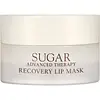What's inside
What's inside
 Key Ingredients
Key Ingredients

 Benefits
Benefits

 Concerns
Concerns

 Ingredients Side-by-side
Ingredients Side-by-side

Isononyl Isononanoate
EmollientPolybutene
C10-30 Cholesterol/Lanosterol Esters
EmulsifyingBis-Diglyceryl Polyacyladipate-2
EmollientDiisostearyl Malate
EmollientPolyethylene
AbrasiveIsostearyl Isostearate
EmollientHydrogenated Polyisobutene
EmollientVitis Vinifera Seed Oil
EmollientRhus Verniciflua Peel Wax
Ethylene/Propylene/Styrene Copolymer
Vinyl Dimethicone/Methicone Silsesquioxane Crosspolymer
Butyrospermum Parkii Butter
Skin ConditioningButyrospermum Parkii Butter Unsaponifiables
Skin ConditioningSucrose Tetrastearate Triacetate
EmollientRibes Nigrum Seed Oil
EmollientTocopherol
AntioxidantAscorbyl Palmitate
AntioxidantParfum
MaskingButylene/Ethylene/Styrene Copolymer
Ammonium Glycyrrhizate
MaskingEthylhexyl Palmitate
EmollientVanillin
MaskingPentaerythrityl Tetra-Di-T-Butyl Hydroxyhydrocinnamate
AntioxidantTrihydroxystearin
Skin ConditioningSodium Hyaluronate
HumectantLimonene
PerfumingCitral
PerfumingBenzyl Alcohol
PerfumingLinalool
PerfumingIsononyl Isononanoate, Polybutene, C10-30 Cholesterol/Lanosterol Esters, Bis-Diglyceryl Polyacyladipate-2, Diisostearyl Malate, Polyethylene, Isostearyl Isostearate, Hydrogenated Polyisobutene, Vitis Vinifera Seed Oil, Rhus Verniciflua Peel Wax, Ethylene/Propylene/Styrene Copolymer, Vinyl Dimethicone/Methicone Silsesquioxane Crosspolymer, Butyrospermum Parkii Butter, Butyrospermum Parkii Butter Unsaponifiables, Sucrose Tetrastearate Triacetate, Ribes Nigrum Seed Oil, Tocopherol, Ascorbyl Palmitate, Parfum, Butylene/Ethylene/Styrene Copolymer, Ammonium Glycyrrhizate, Ethylhexyl Palmitate, Vanillin, Pentaerythrityl Tetra-Di-T-Butyl Hydroxyhydrocinnamate, Trihydroxystearin, Sodium Hyaluronate, Limonene, Citral, Benzyl Alcohol, Linalool
Diisostearyl Malate
EmollientHydrogenated Polyisobutene
EmollientHydrogenated Poly(C6-14 Olefin)
EmollientMicrocrystalline Wax
Emulsion StabilisingPolyethylene
AbrasiveEthylene/Propylene/Styrene Copolymer
Fragaria Ananassa Seed Oil
AntioxidantHelianthus Annuus Seed Oil
EmollientButyrospermum Parkii Butter
Skin ConditioningSqualane
EmollientTocopherol
AntioxidantSaccharin
MaskingPentaerythrityl Tetra-Di-T-Butyl Hydroxyhydrocinnamate
AntioxidantButylene/Ethylene/Styrene Copolymer
Ethylhexylglycerin
Skin ConditioningHexylene Glycol
EmulsifyingAroma
Caprylyl Glycol
EmollientPhenoxyethanol
PreservativeCI 16035
Cosmetic ColorantCI 77891
Cosmetic ColorantDiisostearyl Malate, Hydrogenated Polyisobutene, Hydrogenated Poly(C6-14 Olefin), Microcrystalline Wax, Polyethylene, Ethylene/Propylene/Styrene Copolymer, Fragaria Ananassa Seed Oil, Helianthus Annuus Seed Oil, Butyrospermum Parkii Butter, Squalane, Tocopherol, Saccharin, Pentaerythrityl Tetra-Di-T-Butyl Hydroxyhydrocinnamate, Butylene/Ethylene/Styrene Copolymer, Ethylhexylglycerin, Hexylene Glycol, Aroma, Caprylyl Glycol, Phenoxyethanol, CI 16035, CI 77891
 Reviews
Reviews

Ingredients Explained
These ingredients are found in both products.
Ingredients higher up in an ingredient list are typically present in a larger amount.
We don't have a description for Butylene/Ethylene/Styrene Copolymer yet.
This ingredient is also known as shea butter. It is an effective skin hydrator and emollient.
Emollients help soothe and soften your skin. It does this by creating a protective film on your skin. This barrier helps trap moisture and keeps your skin hydrated. Emollients may be effective at treating dry or itchy skin.
Shea butter is rich in antioxidants. Antioxidants help fight free-radicals, or molecules that may harm the body. It is also full of fatty acids including stearic acid and linoleic acid. These acids help replenish the skin and keep skin moisturized.
While Shea Butter has an SPF rating of about 3-4, it is not a sunscreen replacement.
Shea butter may not be fungal acne safe. We recommend speaking with a professional if you have any concerns.
Learn more about Butyrospermum Parkii ButterDiisostearyl Malate is an emollient and most often used in lip products. It comes from isostearyl alcohol, a fatty acid, and malic acid, an AHA.
As an emollient, Diisostearyl Malate helps create a thin film on your skin to trap moisture in. This helps keep your skin soft and smooth.
We don't have a description for Ethylene/Propylene/Styrene Copolymer yet.
Hydrogenated Polyisobutene is a synthetic polymer. Polymers are compounds with high molecular weight. Hydrogenated Polyisobutene is an emollient and texture enhancer.
In one study, Hydrogenated Polyisobutene showed better skin hydration levels than Caprylic/Capric Triglyceride. As an emollient, it helps keep your skin soft and hydrated by trapping moisture in.
Hydrogenated Polyisobutene is often used as a mineral oil replacement.
Learn more about Hydrogenated PolyisobutenePentaerythrityl Tetra-Di-T-Butyl Hydroxyhydrocinnamate (long name, huh?) is a synthetic antioxidant.
It is used to help stabilize other antioxidants or prevent the color from changing in a product.
As an antioxidant, it helps fight free-radical molecules. Free-radical molecules are capable of damaging our cells and other genetic material. Thus, antioxidants may reduce the signs of aging.
This ingredient is oil-soluble.
Learn more about Pentaerythrityl Tetra-Di-T-Butyl HydroxyhydrocinnamatePolyethylene is a synthetic ingredient that helps the skin retain moisture. It is a polymer.
It is also typically used within product formulations to help bind solid ingredients together and thicken oil-based ingredients. When added to balms and emulsions, it helps increase the melting point temperature.
Tocopherol (also known as Vitamin E) is a common antioxidant used to help protect the skin from free-radicals and strengthen the skin barrier. It's also fat soluble - this means our skin is great at absorbing it.
Vitamin E also helps keep your natural skin lipids healthy. Your lipid skin barrier naturally consists of lipids, ceramides, and fatty acids. Vitamin E offers extra protection for your skin’s lipid barrier, keeping your skin healthy and nourished.
Another benefit is a bit of UV protection. Vitamin E helps reduce the damage caused by UVB rays. (It should not replace your sunscreen). Combining it with Vitamin C can decrease sunburned cells and hyperpigmentation after UV exposure.
You might have noticed Vitamin E + C often paired together. This is because it is great at stabilizing Vitamin C. Using the two together helps increase the effectiveness of both ingredients.
There are often claims that Vitamin E can reduce/prevent scarring, but these claims haven't been confirmed by scientific research.
Learn more about Tocopherol